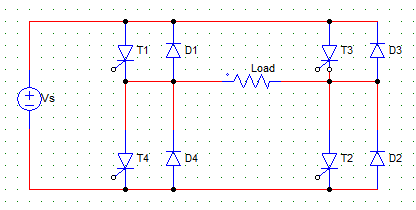This set of Power Electronics Multiple Choice Questions & Answers (MCQs) focuses on “PWM Inverters-5”.
1. In case of multiple pulse width modulation method, if the amplitudes of the reference wave and the carrier wave are made equal then, the pulse width =
a) ∞
b) 0
c) 100 °
d) none of the mentioned
View Answer
Explanation: In multiple pulse width modulation, the pulse width is given by
[ 1 – (Vr/Vc) ] x (π/N) (in degrees)
If Vr = Vc
Pulse width = 0.
2. In an inverter, if the fundamental output frequency is 45 Hz, then the frequency of the second lowest order harmonic will be
a) 45 Hz
b) 135 Hz
c) 225 Hz
d) 9 Hz
View Answer
Explanation: The 5th harmonic is the second lowest order harmonic, as only odd numbers of harmonics are present.
Hence, 45 x 5 = 225 Hz.
3. In an inverter, if the fundamental output frequency is 45 Hz, then the frequency of the lowest order harmonic will be
a) 45 Hz
b) 225 Hz
c) 15 Hz
d) 135 Hz
View Answer
Explanation: The 3rd harmonic is the lowest order harmonic, as only odd numbers of harmonics are present.
Hence, 45 x 3 = 135 Hz.
4. A VSI will have a better performance if its
a) load inductance is small and source inductance is large
b) both load inductance and source inductance are small
c) both load inductance and source inductance are large
d) none of the mentioned
View Answer
Explanation: Higher value of source inductance will increase the overlap angle and cause commutation issues. Hence, both load inductance and source inductance should be small.
5. A single-phase bridge inverter has a square wave output voltage waveform, with odd harmonics present. What is the percentage of the fifth harmonic component to the fundamental component?
a) 50 %
b) 25 %
c) 20 %
d) 5 %
View Answer
Explanation: For the fundamental comoponent, n = 1 and for the fifth harmonic n = 5
1/5 = 0.2 = 20 %.
6. Find, the maximum rms value of the fundamental component of the output voltage for the below given single pulse width modulated circuit. Take Vs = 68 V.

a) 86.6 sin(d)
b) 64 sin(d)
c) 244 sin(d)
d) none of the mentioned
View Answer
Explanation: Vo1 = (4Vs/π) sin(d) = 86.6 sin(d).
7. Control of frequency and control of voltage in 3-phase inverters is
a) possible only through inverter control circuit
b) possible through the control circuit of inverter and converter
c) possible through inverter control of frequency and through converter control for voltage
d) none of the mentioned
View Answer
Explanation: Control of frequency and control of voltage in 3-phase inverters is possible through inverter control of frequency and through converter control for voltage.
8. Output voltage of a single-phase bridge inverter, fed from a fixed dc source is varied by
a) varying the switching frequency
b) pulse-width modulation
c) pulse amplitude modulation
d) all of the mentioned
View Answer
Explanation: The output voltage is controlled by PWM techniques.
9. A single-phase bridge inverter, fed from a 230 V dc is connected to the load R = 10 Ω and L = 0.03 H. Determine the fundamental component of rms output current. Fundamental output frequency of the square wave output = 50 Hz.
a) 30 A
b) 15 A
c) 2.3 A
d) 20.7 A
View Answer
Explanation: Vo1 (rms fundamental voltage) = 4Vs/π√2 = 207.10 V.
Now, the load impedance at the fundamental frequency i.e. at 50 Hz will be
Z1 = [102 + (2π x 50 x 0.03)2]1/2 = 13.7414 Ω
Hence, I = V1/Z1 = (207.10)/(13.7414) = 15.07 A.
10. A single-phase bridge inverter, fed from a 230 V dc is connected to the load R = 10 Ω and L = 0.03 H. The output is a quasi-square wave with an on period of 0.5 of a cycle. Determine the fundamental component of rms output voltage.
a) 207.10 V
b) 146.42 V
c) 265.4 V
d) 129 V
View Answer
Explanation: For quai-square wave or single-pulse width modulated wave pulse width 2d = 0.5 x 180° = 90° or d = 45°
Hence, Vo1 = (4Vs/π√2) sind = (4 x 230)/( π.√2) sin45° = 146.423 V.
Sanfoundry Global Education & Learning Series – Power Electronics.
To practice all areas of Power Electronics, here is complete set of 1000+ Multiple Choice Questions and Answers.
If you find a mistake in question / option / answer, kindly take a screenshot and email to [email protected]
